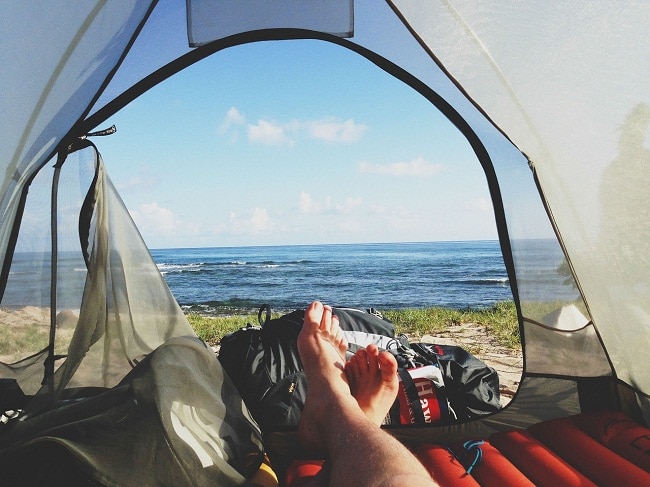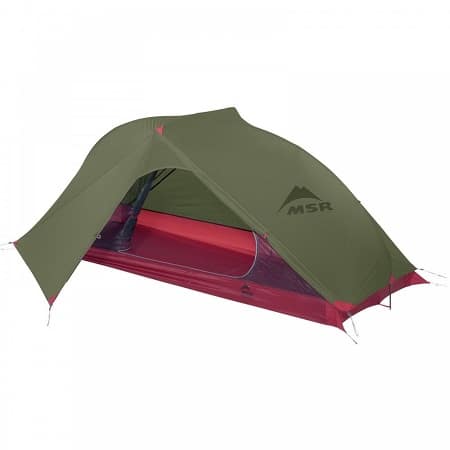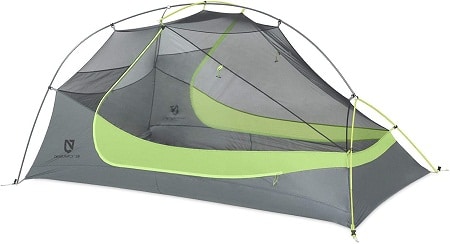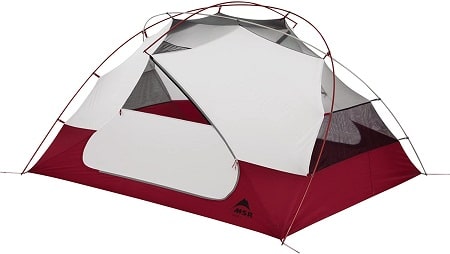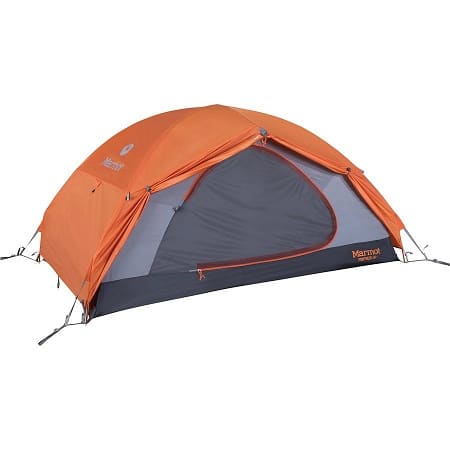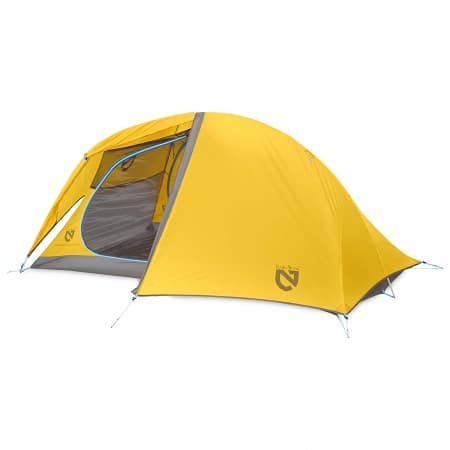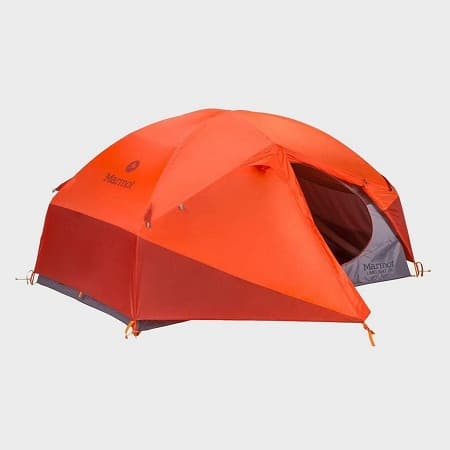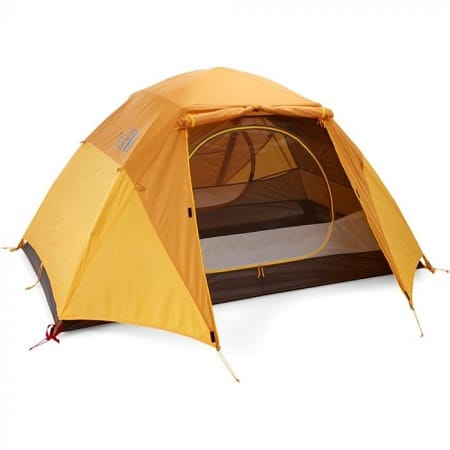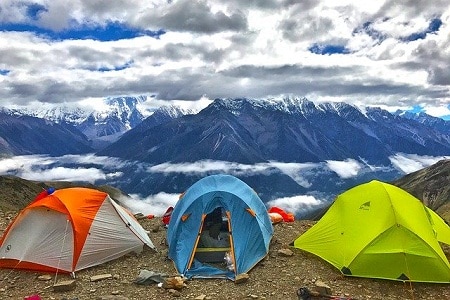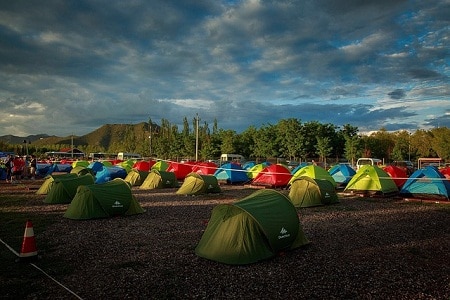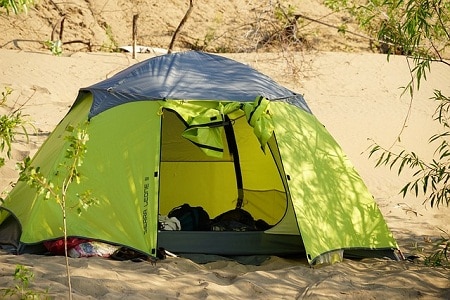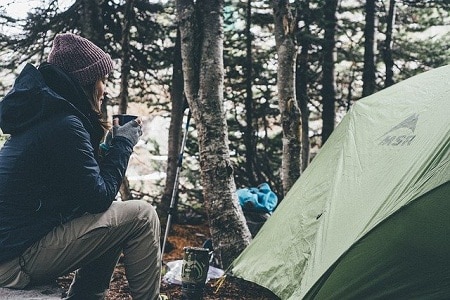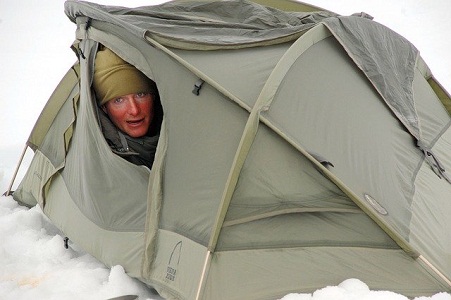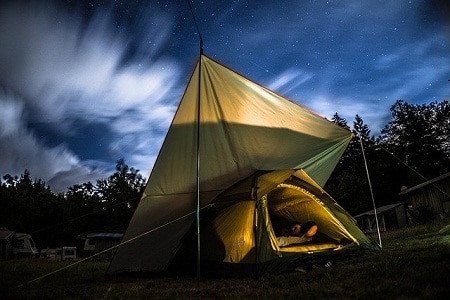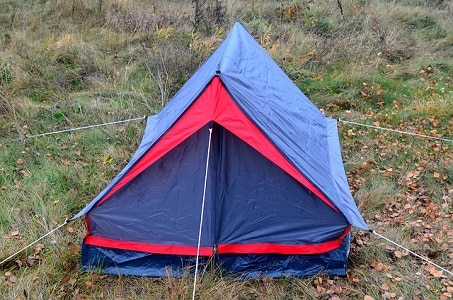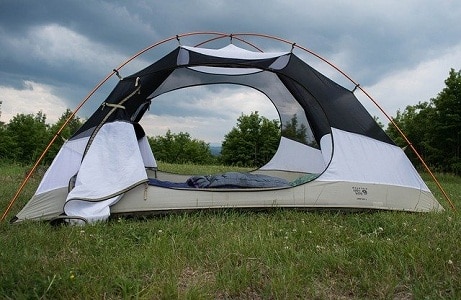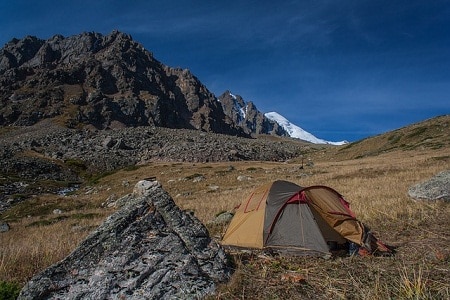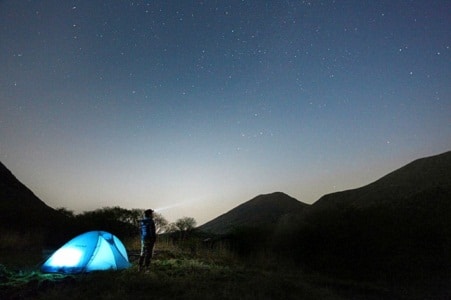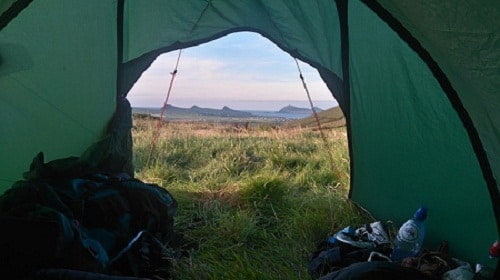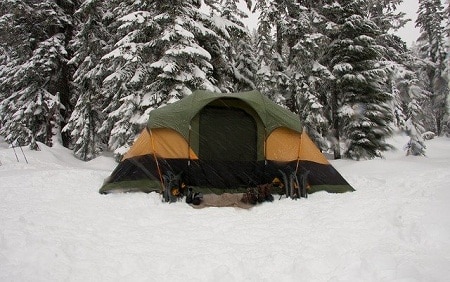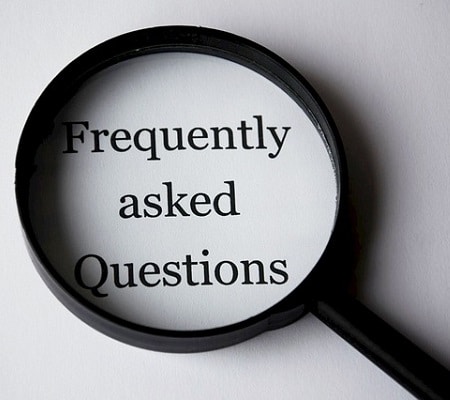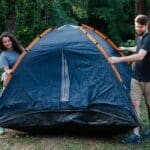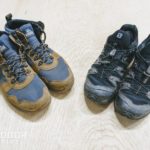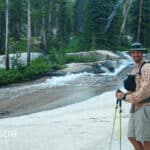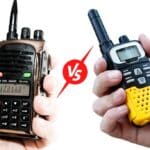Sleeping under the stars in the great outdoors is a fantastic way to get out and truly enjoy nature. However, going out on a backpacking trip without the right gear is sure to be a recipe for disaster.
You need to be sure that you have the appropriate gear to take on any conditions you might face, particularly when it comes to a hiking tent. Without a lightweight backpacking tent, your night under the stars can turn into a cold and miserable evening of waiting for the sun to finally rise.
That being said, we know that there are a whole lot of different options to choose from when it comes to hiking tents, so we understand if you’re feeling a bit overwhelmed.
To help you out, we’ve put together the ultimate guide to choosing a tent for backpacking so you know what to look for when you’re shopping for your next camping shelter.
The 10 Best Backpacking Tents of 2021: Outdoor Empire Reviews
Looking for the best backpacking tent? Here are ten of the best models around:
- Best 1-Person #1: MSR Hubba NX 1
- Best 1-Person #2: MSR Carbon Reflex 1
- Best 2-Person #1: Big Agnes Copper Spur HV UL 2
- Best 2-Person #2: Nemo Dragonfly Ultralight
- Best 3-Person #1: MSR Elixer 3
- Best 3-Person #2: Marmot Fortress 3
- Best Ultralight #1: Black Diamond Mega Light
- Best Ultralight #2: Nemo Hornet Elite Ultralight 2
- Best Affordable #1: Marmot Limelight 2
- Best Affordable #2: The North Face Stormbreak 2
| Category | Best 1-person | Best 2-person | Best Ultralight |
|---|---|---|---|
| Product | 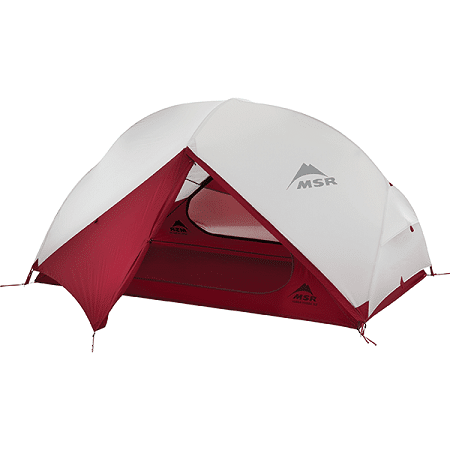 | 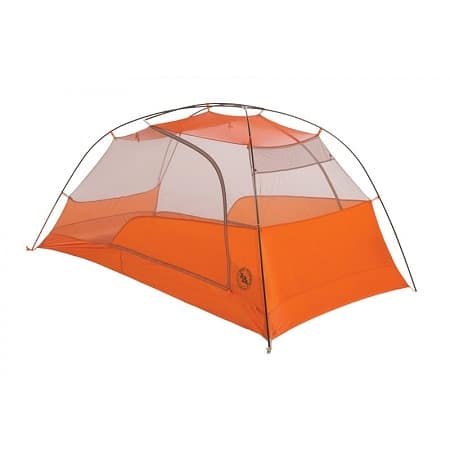 | 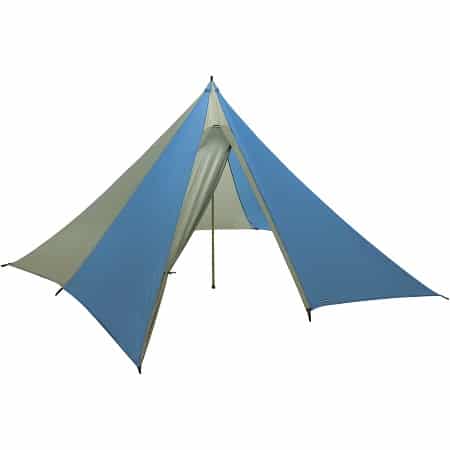 |
| Weight | 2 lbs 15 oz | 3 lbs 2 oz | 2 lbs 13 oz |
| Packed Size | 18 x 6 in | 5 x 6 in | 5 x 10 in |
| Freestanding | Yes | Yes | No |
| Rainfly Fabric | 20D ripstop nylon with 1,200-millimeter Xtreme Shield waterproofing | Mixed denier ripstop nylon with 1,200-millimeter-grade waterproof polyurethane coating | 35D SilNylon |
| Best For | Solo backpackers who spend most of their time in the mountains in the summer | Summer campers who want a bit of extra luxury and vestibule space | Campers who want a lightweight shelter for a large group |
| Cost | Check Price | Check Price | Check Price |
1. Best 1-Person Backpacking Tent #1: MSR Hubba NX 1
The MSR Hubba NX 1 is an uber-popular tent for the lightweight solo camper. Designed specifically for three-season use where weight is a top concern, the Hubba NX 1 features a simple, yet durable construction.
The Hubba NX 1 has just a single Easton Syclone pole, which is robust, lightweight, and easy to use. The tent itself is made with an X-treme Shield waterproof coating to keep you dry even in foul weather, while the large StayDry door makes it easy to get in and out of the tent at night.
Oh, and the Hubba NX 1 packs down small into a compression stuff sack, so it’s the perfect companion on your solo adventures.
Important Specifications
- Weight: 2 pounds 15 ounces (1.33 kilograms)
- Packed Size: 18 inches x 6 inches (46 centimeters x15 centimeters)
- Freestanding: Yes
- Rainfly Fabric: 20D ripstop nylon with 1,200-millimeter Xtreme Shield waterproofing
Pros
- Lightweight and compact
- Single pole makes set up easy
- Large door for easy access
- Plenty of interior space
- Large vestibule for gear storage
Cons
- Expensive for a solo tent
- Not good for four-season use
Who This Tent Is For: Solo backpackers who spend most of their time in the mountains in the summer.
2. Best 1-Person Tent #2: MSR Carbon Reflex 1
As one of the lightest double-walled one-person tents on the market today, the MSR Carbon Reflex 1 is ready for any adventure.
The Carbon Reflex 1 provides all the weather resistance, durability, and comfort of a regular tent but weighs just as much as the average tarp, allowing backpackers the weight savings they need to charge up the trail.
How does the Carbon Reflex 1 weigh so little, you might ask? Well, MSR built the Carbon Reflex 1 with the lightest materials on the market today, including carbon-fiber poles and a zipper-free vestibule.
Plus, the design of the tent is super simple, so there’s no wasted fabric or materials in the Carbon Reflex 1. It’s everything you need and nothing you don’t.
Important Specifications
- Weight: 1 pound 13 ounces (0.79 kilograms)
- Packed Size: 17 inches x 5 inches (43 centimeters x 13 centimeters)
- Freestanding: No
- Rainfly Fabric: 7D ripstop nylon with 1,200-millimeter Durashield waterproofing
Pros
- Incredibly lightweight and compact
- Simple design makes pitching easy
- Generous amount of interior space
- Small vestibule for gear storage
Cons
- Very expensive for solo tent
- 7D rainfly fabric is very thin and prone to tearing
Who This Tent Is For: Anyone who values weight savings and compactness in their tent above all else but still wants to sleep in a tent, not a tarp.
3. Best 2-Person Backpacking Tent #1: Big Agnes Copper Spur HV UL 2
The Big Agnes Copper Spur HV UL 2 is a unique and innovative take on the classic two-person backpacking tent design. The Copper Spur HV UL 2 has two doors and two vestibules to make entry and exit simple and convenient while also giving you plenty of gear storage space.
The tent is easy to set up and even comes with Velcro tabs to connect the tent to the pole for added stability. You can even trade out the standard fly for a larger one with awnings when you’re headed out on a trip where more vestibule space would be ideal.
The best part? Inside the Copper Spur HV UL 2 is Big Agnes’s proprietary mtnGLO system, which provides LED lighting anywhere your adventures might take you.
Important Specifications
- Weight: 3 pounds 2 ounces (.42 kilograms)
- Packed Size:5 inches x 6 inches (50 centimeters x 15 centimeters)
- Freestanding: Yes
- Rainfly Fabric: Mixed denier ripstop nylon with 1,200-millimeter-grade waterproof polyurethane coating
Pros
- Useful mtnGLO feature lights the tent up without a headlamp
- Easy to set up with Velcro attachments for connecting fly to pole
- Relatively lightweight
- Interchangeable rain flies allow for customized set up on different trips
Cons
- Not a lot of interior space
- Not stable enough for very high winds
- Not good in snow
Who This Tent Is For: Summer campers who want a bit of extra luxury and vestibule space.
4. Best 2-Person #2: Nemo Dragonfly Ultralight
The Nemo Dragonfly Ultralight is one of the few tents on the market today that find a decent compromise between weight savings and functionality. The Dragonfly Ultralight is a freestanding tent with two large trapezoidal vestibules that can fit plenty of gear for storage.
Meanwhile, the tent provides maximum headroom and a white no-see-’em mesh for added breathability and ventilation in the summer months.
The Dragonfly Ultralight can be pitched in minutes with a single pre-bent hub-style pole that’s color coded for easy setup. Plus, the tent has plenty of internal pockets, so you can organize your most important gear.
The tent even comes with two stuff sacks so you can easily split the weight between you and your hiking partner.
Important Specifications
- Weight: 3 pound 2 ounces (1.41 kilograms)
- Packed Size:5 inches x 4.5 inches (50 centimeters x12 centimeters)
- Freestanding: Yes
- Rainfly Fabric: 15D ripstop nylon fly with silicone water repellent
Pros
- Lots of interior living space and pockets for gear organization
- Two large vestibules for gear storage
- Simple, color-coded setup with just one pole
- Two stuff sacks to split the weight between both hiking partners
Cons
- Not good in the snow
- Too short for very tall hikers
Who This Tent Is For: Hikers who want a highly livable tent that doesn’t weigh a ton.
5. Best 3-Person Backpacking Tent #1: MSR Elixir 3
A new take on a classic tent design, the MSR Elixir 3 is a freestanding tent created for maximum livability. The Elixir 3 has two large doors that make it easy to enter and exit the tent, while larger vestibules provide ample storage space.
Plus, the Elixir 3 uses a unique pole design that allows for plenty of headroom as well as extra space to comfortably fit adults. The tent has built-in gear pockets for keeping things organized inside your shelter at night.
If that wasn’t enough, the Elixir 3 can even be set up just as a rainfly if you want a fast and light option for quick forays into the backcountry.
Important Specifications
- Weight: 7 pounds (3.19 kilograms)
- Packed Size: 20 inches x 8 inches (51 centimeters x 20 centimeters)
- Freestanding: Yes
- Rainfly Fabric: 68D ripstop polyester with 1,500-millimeter polyurethane and DWR treatment
Pros
- Plenty of interior space and gear storage in the two vestibules
- Large doors for easy access
- Simple setup
- Can be pitched with just the rainfly as a tarp
Cons
- Quite heavy
- Polyester rainfly is bulky and not as durable as ripstop nylon
Who This Tent Is For: Groups of hikers who prioritize living space and comfort over weight savings.
6. Best 3-Person Backpacking Tent #2: Marmot Fortress 3
Simple yet comfortable, the Marmot Fortress 3 is designed to be your home away from home in the mountains. The tent features a mesh and fabric inner body as well as a waterproof fly for weather resistance in a storm.
When it comes to interior living space, the Fortress 3 has pre-bent poles that create straight walls for extra headroom at night. It’s even easy to pitch the Fortress 3 in just a few minutes, thanks to the tent’s color-coded poles and clips.
Oh, and the Fortress 3 comes with a lampshade pocket that lets you hang up your headlamp to provide light to the entire tent at night.
Important Specifications
- Weight: 6 pounds 15 ounces (3.14 kilograms)
- Packed Size:5 inches x 8 inches (56 centimeters x 20.3 centimeters)
- Freestanding: Yes
- Rainfly Fabric: 68D Polyester Taffeta 150 millimeter
Pros
- Very comfortable and spacious interior
- Affordable
- Straight-sided walls for maximum livability
- Internal pockets for organization
Cons
- Bulky and heavy
- Polyester rainfly isn’t as durable as ripstop nylon
- Small vestibules for tent size
Who This Tent Is For: Hikers looking for an affordable tent that doesn’t sacrifice comfort.
7. Best Ultralight Tent #1: Black Diamond Mega Light
The Black Diamond Mega Light is a unique backpacking tent that can be used in nearly any environment. The Mega Light is essentially a cone-shaped tarp made of ultra-durable fabric that can be combined with Black Diamond’s Mega Bug for camping trips when you also want an inner tent.
The Mega Light has enough space for four people and all of their gear. It needs just eight stakes and one pole to pitch, though you can also use your trekking poles instead, if you want to save some weight.
Best of all? The Mega Light can even be used as an ultra-light shelter in the winter, so it’s really a one-size-fits-all tent for all your adventures.
Important Specifications
- Weight: 2 pound 13 ounces (1.27 kilograms)
- Packed Size: 5 inches x10 inches (13 centimeters x 25 centimeters)
- Freestanding: No
- Rainfly Fabric: 35D SilNylon
Pros
- Very lightweight for a four- person tent
- Can be pitched with or without a bug net
- Can substitute single pole with trekking poles or kayak paddles
- Strong, waterproof fabric is easy to repair on extended trips
Cons
- Expensive
- Takes time to learn how to pitch properly
Who This Tent Is For: Campers who want a lightweight shelter for a large group.
8. Best Ultralight Tent #2: Nemo Hornet Elite Ultralight 2
The Nemo Hornet Elite Ultralight 2 is the ultralight backpacker’s new best friend. This ultralight tent is stripped bare for minimalist hikers who need a shelter for the night and little else.
Made with some of the finest materials on the market today, the Hornet Elite keeps weight to an absolute minimum so you can focus more on the trail and less on what’s in your pack.
The Horten Elite provides ample living space and a simple, single-pole construction for fast set-up. It also has a small vestibule so you can store your gear at night without worry.
Important Specifications
- Weight: 2 pounds 1 ounce (935 grams)
- Packed Size: 19 inches x 4.5 inches (48 centimeters x 12 centimeters)
- Freestanding: Yes
- Rainfly Fabric: 7D ripstop nylon
Pros
- Incredibly lightweight
- Easy to set up
- Small vestibule for gear storage
- Plenty of living space for a single person
Cons
- Very expensive
- Rainfly fabric is very thin and can rip easily
Who This Tent Is For: Ultralightweight and minimalist hikers who won’t compromise on weight.
9. Best Affordable Backpacking Tent #1: Marmot Limelight 2
The Marmot Limelight 2 is a simple and affordable no-frills tent for the backpacker on a budget. Designed for comfort, the Limelight 2 has vertical walls for more headroom and sleeping space.
It has an easy-pitch design, thanks to its color-coded tabs and poles, as well as an included footprint for protection from sharp sticks and rocks.
With the Limelight 2, you can store your gear inside the tent’s interior pockets or in the tent’s large vestibule. Plus, the Limelight 2’s large door makes entry and exit from the tent a breeze.
Important Specifications
- Weight: 5 pounds 10 ounces (2.55 kilograms)
- Packed Size:5 inches x 7.5 inches (51 centimeters x 17.8 centimeters)
- Freestanding: Yes
- Rainfly Fabric: 68D Polyester Taffeta 1,500-millimeter waterproofing
Pros
- Affordable two-person tent
- Lots of gear storage space
- Plenty of headroom and living space
- Easy to set up with color-coded system
Cons
- Heavy
- Not great in foul weather
- Only one door and vestibule
Who This Tent Is For: Budget-conscious backpackers who want to be comfortable outside.
10. Best Affordable Backpacking Tent #2: The North Face Stormbreak 2
Whether you’re at a campground or deep in the backcountry, the North Face Stormbreak 2 is an affordable shelter for the regular adventurer. The Stormbreak 2 has two large doors and two multi-configuration vestibules that can be instantly customized to meet your needs.
Plus, the Stormbreak 2 has large mesh paneling around the tent body to help keep things ventilated during the warmer summer months. The tent is quick and easy to pitch and provides ample living space, so it’s a great home in the mountains for the camper on a budget.
Important Specifications
- Weight: 5 pounds 14.2 ounces (2.66 kilograms)
- Packed Size: 7 inches x 22 inches (17.7 centimeters x 55.9 centimeters)
- Freestanding: Yes
- Rainfly Fabric: 68D polyester with 3,000-millimeter polyurethane coating
Pros
- Very affordable
- Lots of living space
- Customizable vestibules for added comfort
- Mesh paneling for lots of breathability
Cons
- Heavy for backpacking
- Bulky 68D-polyester rainfly
- Not great in a storm
- Large packed size
Who This Tent Is For: Summertime hikers who take occasional backcountry trips but spend more time in campgrounds.
Learn more about The North Face Stormbreak 2.
Recommended: Best Ultralight Backpacks Buyer’s Guide
How Backpacking Tents Differ From Regular and Family Tents
If you’re new to the world of backpacking tents, you might be wondering how these shelters are different from other models you may have used before, such as a car camping or a family tent.
Basically, it all comes down to what conditions each kind of shelter is designed to be used in, as well as the types of trips they would be brought on.
For example, a backpacking tent is generally going to be a small, compact tent that’s designed for use in remote environments.
This means they often offer less living space and other luxuries because backpacking tent manufacturers are trying to keep the weight and packed size of your tent to an absolute minimum.
For family and car camping tents, however, packed size and weight generally aren’t as big of a concern. Since most family tents are used in “frontcountry” settings (not very far from a road), you often don’t need to carry them very far from your car.
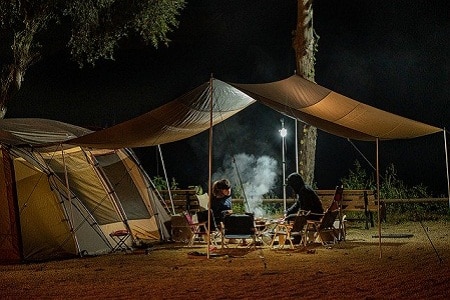
Thus, family and car camping tents tend to be bigger and heavier because they offer more luxuries and interior living space since you don’t need to worry too much about weight.
While you can certainly use a lightweight backpacking tent in a developed campground, you’ll probably find that you’re more comfortable in a family tent in that environment. However, a family or car camping tent would simply be too bulky and heavy to bring into the mountains.
Plus, family and car camping tents just aren’t designed to handle the extreme conditions you’re likely to encounter in a backcountry environment. Therefore, if you’re looking to go on a backpacking trip, you should really invest in a proper backpacking tent, not a family tent.
Looking for a solid car camping family tent? Make sure to check out our Ultimate Buyer’s Guide to the Best Canvas Tents!
Buying Advice
Choosing your next backpacking tent is no easy feat. There are literally hundreds of different models to choose from, each with their own advantages and disadvantages. So, here’s some advice for finding the right tent for your needs:
Choosing a Backpacking Tent
First and foremost, how does one even go about choosing a specific backpacking tent? In reality, it all comes down to finding a tent that’s best suited for your type of outdoor activity.
While there will always be something you could improve with a given tent, the goal is to find one that’s as perfect a match as possible. So, here are some things to keep in mind when choosing a backpacking tent:
Backpacking Location
Where you live and where you plan to do most of your backpacking will have a huge impact on the tent you choose.
For example, if most of your camping is done in low-elevation terrain that’s quite warm, you’ll need a shelter that’s very different from someone that spends a lot of time in high-elevation locales with plenty of snow and wind.
Additionally, if a lot of your backpacking takes place in very remote places (more than 30-40 miles from a road) you’ll want to be sure that you have a tent that’s highly durable and easy to repair in case something goes wrong.
Ultimately, it’s incredibly important to find a tent that’s appropriate for the conditions you plan to use it in.
Backpacking Season
In the world of backpacking, we talk about three-season and four-season tents. Basically, any tent that’s not meant to be used in the winter is considered a three-season tent, while one that’s appropriate for winter use can be considered a four-season model.
If you don’t ever plan to go backpacking in the winter, a three-season tent is going to be more than enough. Three-season models are lighter and more compact than their four-season counterparts and offer more ventilation to keep you cool on warm nights.
Alternatively, four-season models offer better insulation from the cold and are strong enough to withstand the pressure of snow build-up but are generally heavier than three-season tents.
Sleeping Capacity
Every tent comes with an established “sleeping capacity,” which tells you how many people you can fit in the tent at night.
This is often denoted as a number at the end of the tent’s name — for example, the MSR Hubba Hubba 2 is a two-person tent — but you can always read the tent specifications to find out exactly what the sleeping capacity is.
However, do keep in mind that just because a tent is designed to hold four people doesn’t mean it will be comfortable to cram four people inside of it. More often than not, especially with one- and two-person tents, it’s much more comfortable to not fill the tent to capacity in order to have more space at night.
Therefore, many people opt to bring a bigger tent than they actually need. This often means that they have to carry more weight and bulk around, though, so if you’re conscious about carrying extra pounds, a smaller tent is probably best.
Cost
While we all wish that we could spend an unlimited amount of money on gear, the reality is that most of us are on a budget. Thus, the cost of a tent is going to be a major deciding factor when we’re shopping around.
For the most part, lightweight and ultralight tents will be more expensive than their regular counterparts, so if you’re on a budget, you may have to make do with a heavier tent.
However, there are plenty of great affordable tent options out there, so you will likely find something that meets your needs and your budget.
Important Considerations for Backpacking Tents
Before you go out and buy a backpacking tent, you should have a good understanding of the different features of tents. Here are some of the major features to consider when shopping around:
Single vs. Double Wall
Modern tents are classified as either single or double wall based on their construction.
A single-wall tent puts just one layer of fabric between you and the elements, while a double wall tent consists of a tent body (usually made of mesh) and a tent fly, which is a waterproof barrier to protect against rain, snow, and wind.
As you can imagine, a single-wall tent is usually the lighter option, but they tend to be both less durable and less water resistant. A double wall tent is generally the heavier option, but these models tend to be more durable, more water resistant, and more breathable in warm weather.
Freestanding vs. Not Freestanding
While some tents can be pitched as free-standing shelters, others need to be staked to the ground in order to take their shape. Although you should always anchor your tent to the ground, freestanding tents tend to be easier to pitch than non-freestanding models.
Many people won’t really care too much about this distinction, but if you find pitching a tent to be difficult, you’ll probably want to go with a freestanding option.
Doors
The number, size, and location of the doors in your tent might not seem like a big deal, but they can make a huge difference in your camping experience.
Large doors are easier to get in and out of, but having more doors can make it so you don’t have to crawl over your tent mates at night to go to the bathroom. However, having more doors and having larger doors means having more zippers, which adds weight and cost to your tent.
Vestibules
A vestibule is basically a covered space above the doors of your tent. These are incredibly useful for storing gear and for keeping you dry as you get in and out of the tent.
However, not all tents come with vestibules, and those that do tend to be a bit heavier than those that don’t. But, if you camp in a particularly rainy or snowy area, a vestibule is a must-have for your tent.
Ease of Setup
Pitching a tent can be difficult, so it’s nice to get a model that offers a quick and easy setup process. While some tents come with five or more different poles, others have just one pole and color-coded tabs to make your life easier.
So, if you’re not keen on setting up tricky tents, you might want to look for a model that has a fast setup option.
Footprint
The footprint of a tent refers to the amount of size it takes up on the ground, also known as its square footage. As you can imagine, a tent with a smaller sleeping capacity will have a smaller footprint than one that has a larger capacity.
Having a tent with a smaller footprint is ideal if you often camp in a place with a lot of rocks and boulders or otherwise limited camping options, since a larger footprint tent will need more space to pitch.
Packed Size
The packed size of a tent makes a huge difference in your day-to-day life while backpacking. Unless you plan to carry a massive pack, a large tent will take up a lot of space, making it annoying to pack your bag every morning.
A compact tent is relatively easy to pack, and allows you more room for other essential pieces of gear.
Weight
No one likes to carry around heavy gear, so a lightweight backpacking tent is ideal. However, do keep in mind that weight savings (and packed size) are often a compromise between durability and cost.
Therefore, you often have to decide whether you want to spend a bit more to get a more durable lightweight tent option.
Durability
The durability of a tent is of the utmost importance because you don’t want to have to buy a new tent after just a few trips.
That being said, many manufacturers compromise durability in order to get some weight savings in their tents. Be sure to look for robust poles and quality fabrics when you’re buying a new backpacking tent.
Weather Resistance
Since a tent is primarily designed to keep you warm and dry, a backpacking tent’s weather resistance is critical. Most tents will use a waterproof fabric as part of their tent fly, which is designed to keep you dry in the rain and snow.
Seam-taped and seam-sealed fabrics are essential if you don’t want a steady drip of water on your forehead at night as you sleep.
Plus, you want to be sure that your tent can hold up well in high winds. Often this comes down to the shape of the tent, as well as the durability of the poles and guy lines that keep it upright.
FAQ
Here are our answers to some of your most common questions about backpacking tents:
How do I pack a tent for backpacking?
Packing a tent for backpacking is a skill, to say the least, so it’s understandable if you’re struggling with the process. Essentially, you have two main options for packing your tent — either stuffing it into your pack or rolling it up into the included stuff sack.
In the first method, you’ll want to line the inside of your pack with a pack liner or a durable garbage bag. Then you want to place the tent pole inside the pack but on the outside of the pack liner, flush against the back of the pack (where your back rests).
Then, after you’ve packed your gear into the pack, you can then roll up the garbage bag and stuff the tent fly and body into your pack on the outside of the pack liner. This helps prevent the rest of your gear from getting wet while also protecting your tent from damage.
Alternatively, you can roll your tent up and place it or stuff it into the included stuff sack. When using this method, most people then attach the tent bag to the outside of their pack.
However, this is not recommended because it will get your tent body wet if it rains, and it also makes it easy to damage your tent as you hike.
Is a tent footprint necessary?
A tent footprint is basically a ground cloth that you can place under your tent when you pitch it. Tent footprints help protect your tent floor from sticks and rocks and can prevent it from getting filled with holes.
However, they add weight to your pack and aren’t always worth the extra bulk and hassle. If you camp a lot on very rocky terrain and have a very expensive tent, it might be worth carrying a footprint. Otherwise, you probably don’t need one.

